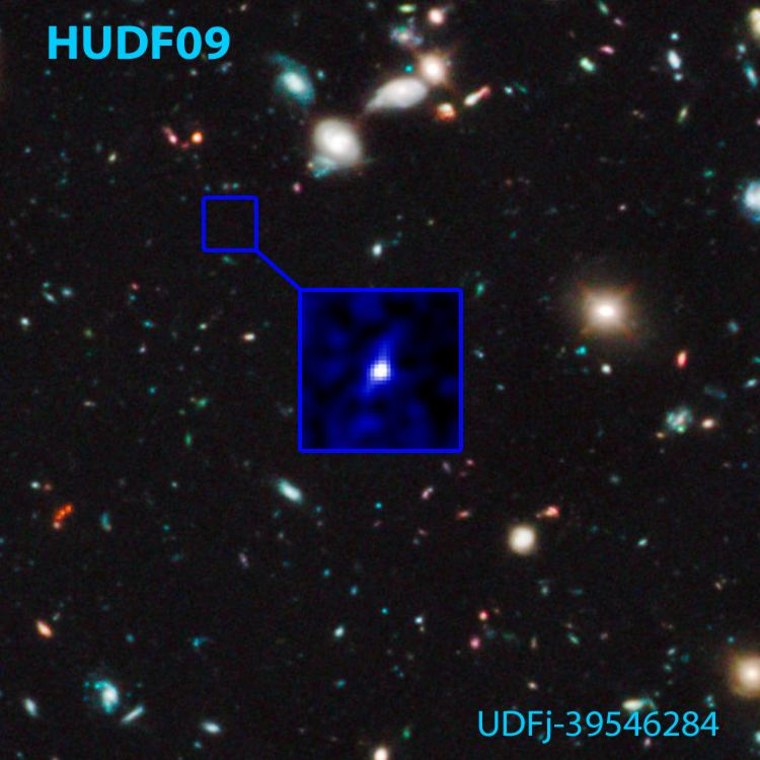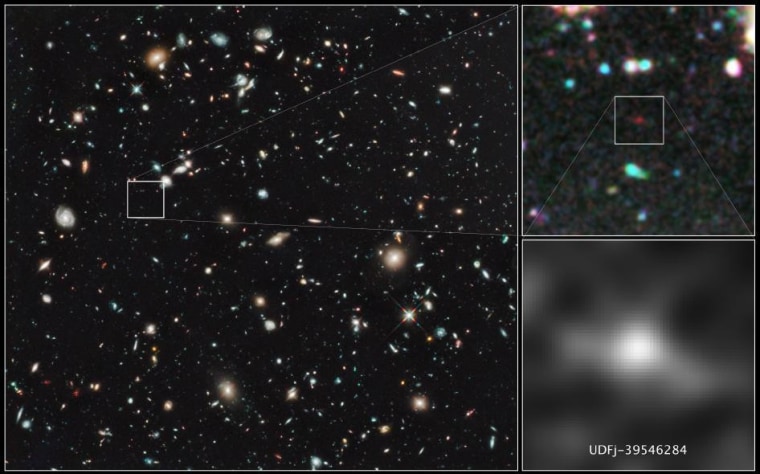The Hubble Space Telescope has outdone itself by catching sight of what may be the most distant galaxy ever seen, lying about 13.2 billion light-years from Earth. If the observations hold up, they would one-up another galaxy that made headlines last October when researchers said it was 13.1 billion light-years away.
The newfound galaxy candidate, discussed in this week's issue of the journal Nature, is known by the unwieldy name UDFj-39546284. (Let's call it UDFj for short.) Like the earlier candidate for the farthest galaxy, UDFy-38135539, it was detected amid other faint galaxies in a snapshot of the sky known as the Hubble Ultra Deep Field.
This particular candidate was singled out during an exhaustive search of the deep-field data in infrared wavelengths, which was gathered during 87 hours of observations by Hubble's Wide Field Camera 3 in 2009 and 2010. Based on the characteristic shift in UDFj's light spectrum, astronomers determined that the galaxy dated back to a time just 480 million years after the big bang.

"Our previous searches had found 47 galaxies at somewhat later times, when the universe was about 650 million years old. However, we could only find one galaxy candidate just 170 million years earlier," Garth Illingworth of the University of California at Santa Cruz, a leader of the research team, said today in a news release. "The universe was changing very quickly in a short amount of time."
Among the galaxies used for comparison were the previous "farthest galaxy" and two others dating to around the same time period. The distances for super-faraway galaxies are usually expressed in terms of their redshift factor, or "z." The higher the number, the more distant the galaxy. The three comparison galaxies were at redshift 8.2 or more. The team involved in last October's research report said that UDFy-38135539 was at redshift 8.55. UDFj had a redshift factor of 10.3, Illingworth and his colleagues reported.
The researchers said the galaxy candidate was less than 1 percent the size of our own Milky Way galaxy. They also said there was a 20 percent chance that the object is "a contaminant or is spurious." It's possible that an anomaly is making the galaxy look older than it really is. There's even a remote possibility that the galaxy doesn't exist at all.
"We're really pushing Hubble to its limits here," Illingworth told journalists today during a NASA teleconference.
To reassure themselves that UDFj truly existed, they matched their data against models for galaxy formation and determined that their candidate fit the models. They also checked the same location in the Hubble Ultra Deep Field against infrared imagery from NASA's Spitzer Space Telescope. If Spitzer detected the galaxy as well, that might have signaled that the galaxy was closer than the researchers thought. But UDFj didn't show up on the Spitzer imagery. ""That's actually good news," Illingworth said.
These tests took months to complete, and they led the researchers to the conclusion that what they were seeing was real. "We have every reason to believe that this might be a plausible source which existed 500 million years after the big bang," said another leader of the research team, Rychard Bouwens, who went from UC-Santa Cruz to Leiden University in the Netherlands.
Not everyone is convinced that this galaxy candidate is everything that the research team says it is. But Rachel Somerville, an astronomer at the Space Telescope Science Inistitute who was not involved in the study, said she thought the results were solid. "This team has done all the right tests," she told me during today's teleconference. "What they've done is very sensible. I would be very surprised, actually, if this turns out to be not high-redshift."

It's significant that only one object was representative of an epoch 480 million years after the universe's origin, but that 47 galaxies were associated with the 650 million-year-old universe. That growth rate would be consistent with the idea that galaxies grew up rapidly from the seeds of stars under the gravitational influence of dark matter, Bouwens said.
Somerville focused on that aspect of the team's findings. "Perhaps the most interesting part of this research is the 'dog that didn't bark,'" she said, referring to a classic bit of Sherlock Holmes lore. Based on the number of galaxies detected at 650 million years, "they should have seen 10 times more galaxies" at 480 million years, she said. The fact that they didn't lends weight to the idea that the epoch between the 480 million-year mark and the 650 million-year mark was a key time for galaxy growth.
Illingworth said the galactic growth rate must have been much faster during that interval than it is today.
"The peak of starbirth in the universe occurred about 10 billion years ago, and it turned over gradually," he observed. "Basically, since the last half of the life of the universe, the starbirth rate has been dropping quite distinctly and dramatically. So we're in a very quiescent time in the universe, compared to what it was at the maximum. In fact, we're almost back to where we were at this 500 million-year age. It's sort of like the universe is aging, and nothing much is happening."

So what was the galactic growth rate before the 480 million-year mark? That's impossible to tell right now. When it comes to measuring galaxy distances, redshift 10 is just about the observing limit for the Hubble Space Telescope. To go back much farther in time and space, astronomers will have to wait for the James Webb Space Telescope, which is currently due for launch in 2014 or 2015. The Webb telescope, also known as the JWST, could also confirm precisely how far away UDFj is.
"It's going to take JWST to do more work at higher redshifts," Illingworth said. "This study at least tells us that there are objects around at redshift 10, and that the first galaxies must have formed earlier than that."
More from the edge of the universe:
- Most distant galaxy cluster discovered
- Nobel physicist focuses on Hubble's heir
- Huge telescopes would probe new frontiers
- Cosmic lenses may distort view of early universe
- Video: NBC's Brian Williams on the Hubble discovery
In addition to Bouwens and Illingworth, the co-authors of the Nature paper, "A Candidate Redshift z~10 Galaxy and Rapid Changes in The Population at an Age of 500 Myr," include Ivo Labbe, Pascal Oesch, Michele Trenti, Marcella Carollo, Pieter van Dokkum, Marijn Franx, Massimo Stiavelli, Larry Bradley, Valentino Gonzalez and Daniel Magee. The research was supported by NASA and the Swiss National Science Foundation.
Illingworth's team maintains the First Galaxies website, offering information about the latest research on distant galaxies.
Join the Cosmic Log community by clicking the "like" button on our Facebook page or by following msnbc.com science editor Alan Boyle as b0yle on Twitter. To learn more about Alan Boyle's book about Pluto and the search for planets, check out the website for "The Case for Pluto."